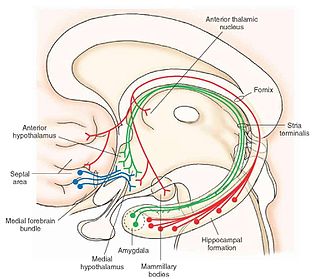A remotely guided rat, popularly called a ratbot or robo-rat, is a rat with electrodes implanted in the medial forebrain bundle (MFB) and sensorimotor cortex of its brain. They were developed in 2002 by Sanjiv Talwar and John Chapin at the State University of New York Downstate Medical Center. The rats wear a small electronics backpack containing a radio receiver and electrical stimulator. The rat receives remote stimulation in the sensorimotor cortex via its backpack that causes the rat to feel a sensation in its left or right whiskers, and stimulation in the MFB that is interpreted as a reward or pleasure.
After a period of training and conditioning using MFB stimulation as a reward, the rats can be remotely directed to move left, right, and forward in response to whisker stimulation signals. It is possible to roughly guide the animal along an obstacle course, jumping small gaps and scaling obstacles.
Concerns have been raised by animal rights groups about the use of animals in this context, particularly due to a concern about the removal of autonomy from an independent creature. For example, a spokesman of the Dr Hadwen Trust, a group funding alternatives to animal research in medicine, has said that the experiments are an "appalling example of how the human species instrumentalizes other species." [1]
Researchers tend to liken the training mechanism of the robo-rat to standard operant conditioning techniques. Talwar himself has acknowledged the ethical issues apparent in the development of the robo-rat, but points out that the research meets standards for animal treatment laid down by the National Institute of Health. [2] Moreover, the researchers emphasize that the animals are trained, not coerced, into particular behaviors. Because the rats are encouraged to act via the reward of pleasure, not muscularly compelled to behave in a particular manner, their behavior under MFB stimulation is likened to a carrot-and-stick model of encouraged behavior versus a system of mind control. It seems unlikely that the rats could be persuaded to knowingly risk their lives even with this stimulation. "Our animals were completely happy and treated well," Talwar stated. [1]
The technology is reminiscent of experiments performed in 1965 by Dr. Jose Delgado, a controversial scientist who was able to pacify a charging bull via electrodes fitted in its brain. He was also said to control cats and monkeys like "electronic toys." [3] Doctor Robert Galbraith Heath also placed electrodes deep into the brains of patients and wrote hundreds of medical papers on his work.
The mesolimbic pathway, sometimes referred to as the reward pathway, is a dopaminergic pathway in the brain. The pathway connects the ventral tegmental area in the midbrain to the ventral striatum of the basal ganglia in the forebrain. The ventral striatum includes the nucleus accumbens and the olfactory tubercle.

The nucleus accumbens is a region in the basal forebrain rostral to the preoptic area of the hypothalamus. The nucleus accumbens and the olfactory tubercle collectively form the ventral striatum. The ventral striatum and dorsal striatum collectively form the striatum, which is the main component of the basal ganglia. The dopaminergic neurons of the mesolimbic pathway project onto the GABAergic medium spiny neurons of the nucleus accumbens and olfactory tubercle. Each cerebral hemisphere has its own nucleus accumbens, which can be divided into two structures: the nucleus accumbens core and the nucleus accumbens shell. These substructures have different morphology and functions.

Behavioral neuroscience, also known as biological psychology, biopsychology, or psychobiology, is the application of the principles of biology to the study of physiological, genetic, and developmental mechanisms of behavior in humans and other animals.

A brain–computer interface (BCI), sometimes called a brain–machine interface (BMI), is a direct communication pathway between the brain's electrical activity and an external device, most commonly a computer or robotic limb. BCIs are often directed at researching, mapping, assisting, augmenting, or repairing human cognitive or sensory-motor functions. Implementations of BCIs range from non-invasive and partially invasive to invasive, based on how close electrodes get to brain tissue.

Miguel Ângelo Laporta Nicolelis, M.D., Ph.D., is a Brazilian scientist, physician and Duke School of Medicine Professor in Neuroscience at Duke University, best known for his pioneering work surrounding brain-machine interface technology.
Brain implants, often referred to as neural implants, are technological devices that connect directly to a biological subject's brain – usually placed on the surface of the brain, or attached to the brain's cortex. A common purpose of modern brain implants and the focus of much current research is establishing a biomedical prosthesis circumventing areas in the brain that have become dysfunctional after a stroke or other head injuries. This includes sensory substitution, e.g., in vision. Other brain implants are used in animal experiments simply to record brain activity for scientific reasons. Some brain implants involve creating interfaces between neural systems and computer chips. This work is part of a wider research field called brain–computer interfaces.

Wireheading is a term associated with fictional or futuristic applications of brain stimulation reward, the act of directly triggering the brain's reward center by electrical stimulation of an inserted wire, for the purpose of 'short-circuiting' the brain's normal reward process and artificially inducing pleasure. Scientists have successfully performed brain stimulation reward on rats (1950s) and humans (1960s). This stimulation does not appear to lead to tolerance or satiation in the way that sex or drugs do. The term is sometimes associated with science fiction writer Larry Niven, who used the term in his Known Space series. In the philosophy of artificial intelligence, the term is used to refer to AI systems that hack their own reward channel.

Remote control animals are animals that are controlled remotely by humans. Some applications require electrodes to be implanted in the animal's nervous system connected to a receiver which is usually carried on the animal's back. The animals are controlled by the use of radio signals. The electrodes do not move the animal directly, as if controlling a robot; rather, they signal a direction or action desired by the human operator and then stimulate the animal's reward centres if the animal complies. These are sometimes called bio-robots or robo-animals. They can be considered to be cyborgs as they combine electronic devices with an organic life form. Because of the surgery required, and the moral and ethical issues involved, there has been criticism aimed at the use of remote control animals, especially regarding animal welfare and animal rights. A similar, non-invasive application has been reported which stimulates the brain with ultrasound to control the animal. Some applications use vibrations or sound to control the movements of the animals.
Theta waves generate the theta rhythm, a neural oscillation in the brain that underlies various aspects of cognition and behavior, including learning, memory, and spatial navigation in many animals. It can be recorded using various electrophysiological methods, such as electroencephalogram (EEG), recorded either from inside the brain or from electrodes attached to the scalp.

The septal area, consisting of the lateral septum and medial septum, is an area in the lower, posterior part of the medial surface of the frontal lobe, and refers to the nearby septum pellucidum.
The zona incerta (ZI) is a horizontally elongated region of gray matter in the subthalamus below the thalamus. Its connections project extensively over the brain from the cerebral cortex down into the spinal cord.

The medial forebrain bundle (MFB), is a neural pathway containing fibers from the basal olfactory regions, the periamygdaloid region and the septal nuclei, as well as fibers from brainstem regions, including the ventral tegmental area and nigrostriatal pathway.
Brain stimulation reward (BSR) is a pleasurable phenomenon elicited via direct stimulation of specific brain regions, originally discovered by James Olds and Peter Milner. BSR can serve as a robust operant reinforcer. Targeted stimulation activates the reward system circuitry and establishes response habits similar to those established by natural rewards, such as food and sex. Experiments on BSR soon demonstrated that stimulation of the lateral hypothalamus, along with other regions of the brain associated with natural reward, was both rewarding as well as motivation-inducing. Electrical brain stimulation and intracranial drug injections produce robust reward sensation due to a relatively direct activation of the reward circuitry. This activation is considered to be more direct than rewards produced by natural stimuli, as those signals generally travel through the more indirect peripheral nerves. BSR has been found in all vertebrates tested, including humans, and it has provided a useful tool for understanding how natural rewards are processed by specific brain regions and circuits, as well the neurotransmission associated with the reward system.

The reward system is a group of neural structures responsible for incentive salience, associative learning, and positively-valenced emotions, particularly ones involving pleasure as a core component. Reward is the attractive and motivational property of a stimulus that induces appetitive behavior, also known as approach behavior, and consummatory behavior. A rewarding stimulus has been described as "any stimulus, object, event, activity, or situation that has the potential to make us approach and consume it is by definition a reward". In operant conditioning, rewarding stimuli function as positive reinforcers; however, the converse statement also holds true: positive reinforcers are rewarding.
Theresa A. Jones is a researcher and professor at the University of Texas at Austin and the Institute for Neuroscience. Her interests are in neural plasticity across the lifespan, motor skill learning, mechanisms of brain and behavioral adaptation to brain damage, and glial-neuronal interactions. Her research is on the brain changes following stroke, in particular rehabilitation strategies and the brain changes associated with them. She primarily tests rats and uses the Endothelin-1 stroke model. Her most recent work has expanded into the field of microstimulation mapping of the rat cortex.

Electrical brain stimulation (EBS), also referred to as focal brain stimulation (FBS), is a form of electrotherapy used as a technique in research and clinical neurobiology to stimulate a neuron or neural network in the brain through the direct or indirect excitation of its cell membrane by using an electric current. It is used for research or for therapeutic purposes.

Environmental enrichment is the stimulation of the brain by its physical and social surroundings. Brains in richer, more stimulating environments have higher rates of synaptogenesis and more complex dendrite arbors, leading to increased brain activity. This effect takes place primarily during neurodevelopment, but also during adulthood to a lesser degree. With extra synapses there is also increased synapse activity, leading to an increased size and number of glial energy-support cells. Environmental enrichment also enhances capillary vasculation, providing the neurons and glial cells with extra energy. The neuropil expands, thickening the cortex. Research on rodent brains suggests that environmental enrichment may also lead to an increased rate of neurogenesis.
A brain–brain interface is a direct communication pathway between the brain of one animal and the brain of another animal.
A cortical implant is a subset of neuroprosthetics that is in direct connection with the cerebral cortex of the brain. By directly interfacing with different regions of the cortex, the cortical implant can provide stimulation to an immediate area and provide different benefits, depending on its design and placement. A typical cortical implant is an implantable microelectrode array, which is a small device through which a neural signal can be received or transmitted.
Karen Anne Moxon is a Professor of Bioengineering at University of California, Davis and a specialist in brain-machine-interfaces. She is best known for her neural engineering work, and is responsible for the first demonstration of a closed-loop, real-time brain machine interface system in rodent subjects, which was later translated to both non-human primates and humans with neurological disorders. She currently runs the Moxon Neurorobotics Laboratory at the University of California, Davis.